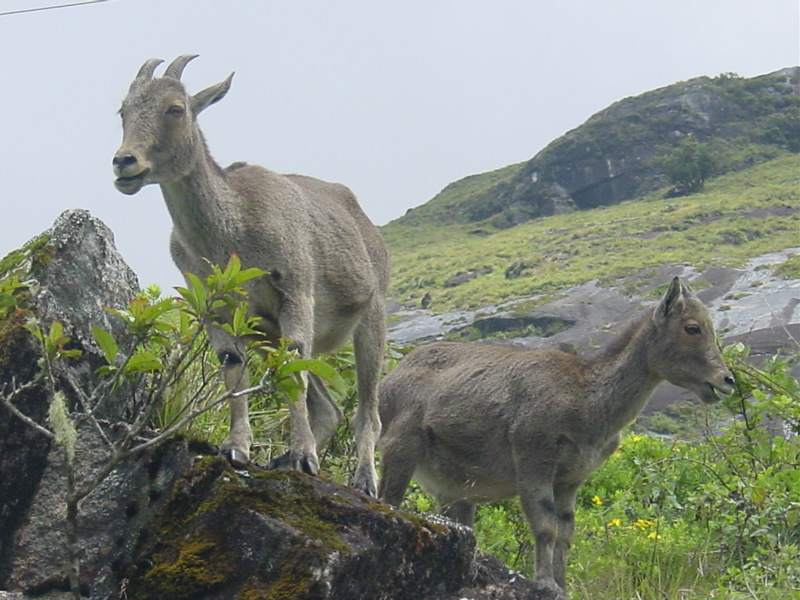Mukurthi National Park near the Otty Hill station is part of Nilgiri Biosphere Reserve, India’s first International Biosphere Reserve.
 Nilgiri Tahr inside Mukurthi National Park near Ooty
Nilgiri Tahr inside Mukurthi National Park near Ooty
Mukurthi National Park comprises a protected area spread across 78.46 square kilometers or 30.3 square miles. It is located in the western corner of the Nilgiris Plateau, west of Ootacamund hill station (popularly known as Ooty) in Tamil Nadu.
Nilgiri Tahr, an endangered species, is the main wild animal seen in this park. One of the reasons why this park was created was to protect these endangered species from extinction. It was first declared a wildlife sanctuary on 3 August 1982 and then made a National Park of India on 15 October 1990.
The Tamil Nadu Forest Department manages Mukurthi National Park. The main objective of this national park is to conserve the endangered Shola grassland ecosystem and its endemic flora and fauna. Artificial firebreaks are made to prevent and control wildfires.
Tourism is not the main objective of this national park, though the Forest Department periodically conducts nature awareness and conservation programs for the public. Some special interest groups, under the guidance of the Forest Department, do arrange controlled visits to the park’s Western catchment and Avalanche areas.
This park was earlier known as Nilgiri Tahr National Park.
This national park is a part of the Nilgiri Biosphere Reserve (India’s first International Biosphere Reserve), part of the Western Ghats. Western Ghats is a UNESCO World Heritage Site too.
Pichalbetta (with a height of 2,544 meters or 8,346 feet), Nilgiri Peak, and Mukurthi Peak are the major mountain peaks of this area.
Fauna
Royal Bengal tigers, Asian elephants, Nilgiri marten, Nilgiri langur, leopard, bonnet macaque, sambar deer, barking deer, mouse deer, otter, small Indian civet, wild dog, jackal, jungle cat, black-naped hare, shrew, Malabar spiny dormouse, soft-furred rat, and Bonhote’s mouse, etc., are there in this park. However, the main attraction is the Nilgiri tahr.
A March 2007 census has estimated around 200 tahrs in the park.
Threatened laughing thrush, whistling thrush, woodcock, black-and-orange flycatcher, Nilgiri flycatcher, wood pigeon, grey-headed flycatcher black bulbul, white-eye, Nilgiri pipit, etc., are some of the bird species in this national park. Black-winged kites, black eagles, and kestrels are also there in the grasslands.
Many species of reptiles are there in this park. Geckos dwarf gecko, Nilgiri salea (Salea horsfieldii), the skink (Kaestlea bilineata), etc., to name a few. Many species of amphibians that are endemic to the region are also there.
Also, many species of Butterflies are there in this park.
Flora
This area is home to numerous endemic plants. Alchemilla indica and Hedyotis verticillaris exist only within this park and its fringes. Rhododendron trees are there in this park.
How Do I Go to Mukurthi National Park?
Mukurthi National Park is accessible from four different routes. All these areas are near Otty Hill Station. The area after the Upper Bhavani Dam is one entry point. Porthimund Dam after Pykara is another entry point to the National Park. The third entry is from T.R. Bazaar near Mudimund. The second and third approach roads are from Ooty – Gudalur – Mysore Road. The fourth entry point is from Parsonsvalley Road.
Udagamandalam Railway Station, alias Ooty Railway Station, is the nearest railway station at about 45 kilometers distance. This is a heritage station and is not connected to any railway network other than the Nilgiri Mountain Railway. Mettupalayam is the nearest broad gauge railway station, with a few trains to other parts of the country. Nilgiri Mountain Railway services, a UNESCO World Heritage site, are available from Mettupalayam to Ooty.
Coimbatore City is the nearest major city with a major railway station and a small international airport.
Best season to Go to Mukurthi National Park
The best season to visit this national park is from February to May or September to November.
